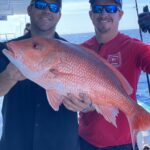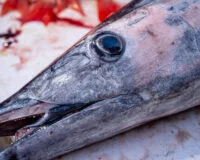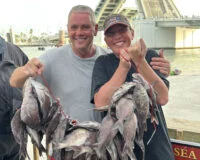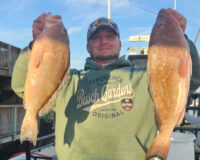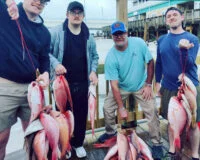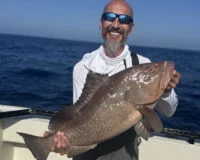Hubbard's Marina Fishing Report
Inshore Fishing Report
Unfortunately, the situation inshore at this time is bleak and only forecasted to get worse along our coastline in the next few days. We are seeing a westerly wind pattern beginning that will concentrate this bloom along our beaches and intercoastal. The only positive news is that Tampa Bay is somewhat clearing up. We have found clear pockets of water in the furthest northern bay waters, but still not a great situation in tampa bay. Plus, a majority of the bait fish have been taken out with some marine mammals even being affected. From the bottom of the food chain to sharks and goliath grouper at the very top we have seen all species affected in this most recent bloom. Very disturbing to say the least driven by endless pollution still continuing to just a few days ago when 1,300 gallons were spilled into the bay.
However, prior to the red tide becoming critical we did see a great snook bite around areas passes. There are still some nice numbers of fish stacked up in passes with minimal concentrations, but unfortunately that will be a thing of the past as this west wind kicks up. Hoping a majority of these fish will make it out of the area to our north where waters are still clean.
There is still some bait fish and schools of redfish moving around in the northern bay, but we are hopeful that we will have some fish survive this event. Typically, fish that move around often and migrate to spawn like snook are able to escape more often of areas of bad water.
Here is to hoping we can get the right people talking and working together towards a positive solution. We need a responsible growth plan to address the sewage and wastewater needs of our ever-growing suburban areas. While also addressing the need of slowing and stopping the continual spills or dumps of fertilizer, wastewater, sewage, and phosphate mining waste into our waterways. Artificial turf lawns are becoming more prolific, and they do not require watering or fertilizer and something like a tax incentive or tax break could make them more affordable for more homeowners and golf course owners alike.
Nearshore Fishing Report
Luckily, the near shore and offshore waters adjacent to the large scale fish kill happening inshore and along the beaches right now are producing great catches at this time and making up for the total loss inshore. However, the issue is that many of these near shore and offshore fish we catch start their life cycles in the estuary waters that are being inundated right now with this incredibly concentrated red tide bloom. The worry we have is the future of our near shore and offshore fisheries if these prolific and concentrated blooms become even more frequent and concentrated as they have been in recent years.
Red grouper action near shore has been going very well for us near shore right now in the deepest near shore waters. We are seeing them biting well closer to around 80-100ft of water on larger strips of cut squid wing, thread fin, or sardines. The live bait has been virtually non existent due to the red tide inshore. Even if we can get the live bait from other areas unaffected, the bait would die on the way offshore at this time. So stick to the smellier larger chunks of dead bait when hunting for the red grouper near shore at this time.
Lane snapper and the occasional mangrove snapper are biting steadily near shore as well. We are seeing some decent snapper action in the deeper near shore water mixed in with the red grouper. We are getting some live shrimp offshore and they are fine through the nasty waters we have inshore right now to allow us a chance to get them offshore for the mangrove snapper and lane snapper offshore. Besides live shrimp cut chunks of threadfin are a great option for targeting snapper near shore when using that double snell rig we suggest on our fishing tips and tricks page. Plentiful grey snapper or white grunts are biting well too with porgies mixed in.
Occasionally we see some scamp grouper and occasionally some gag grouper. However, the red grouper are most prolific and aggressive. The gag grouper bite best offshore right now with the warmer waters the gags will move deeper to cooler waters.
Offshore the gag grouper bite has been much better beyond around 120ft of water or more. Where we are targeting and catch the red snapper with great success is where we are finding more prolific and aggressive gag grouper around 160-200ft of water. Bigger chunks of dead bait like mullet, bonita, mackerel or butterflied big baits are working well for both red snapper and gag grouper.
Mangrove snapper action has been steady out deep too, especially around those larger ledges, peaks and bigger structures. Cut threadfin plugs are best on the double snell rig out deeper when the bite is harder to feel and the fish are more aggressive and prolific.
We are seeing some nice yellowtail snapper action out deep and some big vermillion snapper too. Plus, prolific large porgies and red porgies too. We are seeing plenty of heads and tails mixed in with the gag grouper, scamp grouper, red snapper and fat red grouper offshore.
Pelagic action is going very well offshore too. We are seeing plentiful tuna, steady kingfish, and decent numbers of mahi mahi with the occasional wahoo. Most are being caught on flat lines or free lines but trolling works well if you are targeting these species in the blue water beyond 120ft of water.
DON’T BE A FOOL, bring a venting tool & Descending device ->
Plus, keep in mind the important of dead discards and discard mortality when engaged in near shore or offshore fishing. How many do you know right now that are all for catching and releasing snook, redfish and trout but will be the first in line to kill a mangrove snapper, gag grouper or red snapper and the attitude completely changes when discussing these offshore species? Plus, the same person inshore that will hold their breath and wet their hands before handling a breeder snook will go offshore and then cull through 20 red snapper before keeper their two red snapper they deem large enough to fill their two fish bag limits while the other 18 they released will often end up suffering fatal damage if not properly descended or vented? Please help us to spread the word on the importance of descending or venting your released fish. Descending devices are most easy to use and quick to pick up on their use and are most effective for most anglers. However, an expert and precise angler with proper training and tons of experience can use a venting tool properly with similar outcomes. However, a venting tool requires you to pierce the fish while most descending devices are much less invasive. While using a venting tool it is imperative you pierce them in the exact right spot, and you do not go but a quarter inch or less in the fish. Most venting tools require you to ‘choke up’ on the tool to prevent over penetration into major organs.
When fishing deep water, especially in the hot summer months, please make sure to treat all fish intended to be released like that breeder snook inshore and minimize the time it takes you to get him from the bottom to the boat using heavier proper tackle not an ultra-light spinning reel. Then once on board, minimize the time out of the water. Then use a proper dehooking tool and then for the love of God, use a descending device or venting tool PROPERLY to ensure that fish has a chance to live another day. Three things will help ensure the survivability of those fish released offshore. Making sure they are brought up quickly and do not expend all their energy in the fight. Make sure they are unhooked smoothly, easily, and as quickly as possible. Finally, make sure they spend the least amount of time at the surface at negative pressures where barotrauma exponentially increases its effect with each passing second. Also, keep in mind when the water is warm there is less dissolved oxygen content and the chances of barotrauma increase even more while its effects can be even more deadly. Here’s all the information and more on barotrauma and how to mitigate that fatal damage to your future offshore catch -> https://gulfcouncil.org/eastern-gulf-barotrauma/
**recommend the salt strong articles at the bottom of the page under ‘webpages’ I helped them develop personally**
STATE SURVEY to improve recreational data and access ->
It is imperative that you have your gulf reef fish survey endorsement on your fishing license if you are a private recreational angler or diver fishing from a private boat anywhere in Florida who intends to harvest, attempt to harvest or possess one or more of the following reef fish species: mutton snapper, yellowtail snapper, hogfish, red snapper, vermilion snapper, gag grouper, red grouper, black grouper, greater amberjack, lesser amberjack, banded rudderfish, almaco jack, gray triggerfish, Gag grouper, Red grouper, Scamp grouper, Mangrove snapper, Lane snapper, Kingfish, Tuna, or Mahi mahi. Here is all the information and more on that program and how you can sign up -> https://myfwc.com/fishing/saltwater/recreational/state-reef-fish-survey/
TERMS OF REFERENCE-
INSHORE – from the back bays out to the bridges and including right on the beaches
NEAR SHORE – From the beaches out to 20 miles, or up to 100ft of water
OFFSHORE – from 20 miles or 100ft and beyond
For more fishing reports, photos, videos and more check out Hubbard’s Marina on Facebook, Instagram, YouTube, or Snap Chat just simply search @HubbardsMarina and do not forget our family motto, “If You’re too busy to go fishing, You’re just too busy!” Thanks for reading and checking out our report – Capt Dylan Hubbard, Hubbard’s Marina – Call or Txt me anytime at (727)393-1947 | https://HubbardsMarina.com

